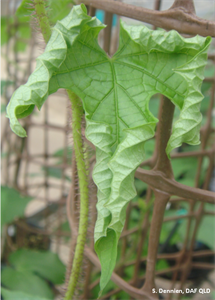- Worldwide distribution. In Oceania, Australia, Papua New Guinea and Solomon Islands. Only known from sweetpotato and ornamental and wild Ipomoea species. Abbreviation is SPLCV. It is a begomovirus.
- Damage: young plants show upward leaf curling, yellowing and vein swelling; later, symptoms disappear, but yields are reduced. If present with e.g., Sweetpotato feathery mottle virus or Sweetpotato chlorotic stunt virus, yield loss is much greater.
- Detection: grafting to Ipomoea setosa, or using ELISA and/or PCR.
- Spread: (i) whiteflies; (ii) cutting used for planting; (iii) sprouts from storage roots. Survival in vines, storage roots, and wild Ipomoea.
- Natural enemies: preserve predators (ladybird beetles, lacewings, hoverflies), and parasitoids.
- Cultural control: use planting material from healthy 'seed' scheme (i.e., mother plants regrown from meristems after heat treatments and tested negatively for SPLCV; weed (especially wild Ipomoea species); plant new crops at least 15 m from old crops; rogue diseased plants; and collect and burn or bury debris at harvest.
- Chemical control: not recommended, uneconomic; if necessary, avoid broad-spectrum insecticides, use insecticidal soaps, white or horticultural oils.
Pacific Pests, Pathogens and Weeds - Online edition
Pacific Pests, Pathogens, Weeds & Pesticides
Sweetpotato leaf curl (376)
Sweetpotato leaf curl
Sweetpotato leaf curl is caused by a virus of the same name. The virus belongs to the begomovirus group, which are transmitted by whiteflies. The abbreviation is SPLCV. The begomoviruses that infect plants in the sweetpotato (Convolvulaceae) family are sometimes called 'sweepoviruses'. Different strains are known.
AUTHORS Sandra Dennien & Grahame Jackson
Information from Clark CA, et al. (2012) Sweet potato viruses: 15 years of progress on understanding and managing complex diseases. Plant Disease 96(2):168-185. (https://apsjournals.apsnet.org/doi/abs/10.1094/PDIS-07-11-0550); and Clark CA, Hoy MW (2007) Effects of common viruses on yield and quality of Beauregard sweetpotato in Louisiana. Plant Disease 90:83-88. (https://apsjournals.apsnet.org/doi/abs/10.1094/PD-90-0083); and Dennien et al. (2013) Growing healthy sweetpotato: best practices for producing planting material. ACIAR Monograph no. 153. Australian Centre for International Agricultural Research: Canberra. 176 pp.; and from Kai-Shu Ling H et al. (2011) Experimental host range and natural reservoir of sweet potato leaf curl virus in the United States. Crop Protection 30(8): 1055-1062. (https://www.sciencedirect.com/science/article/abs/pii/S0261219411000986). Photos 1&2 Sandra Dennien, DAF, Queensland, Australia.
Produced with support from the Australian Centre for International Agricultural Research under projects (i) HORT/2016/185: Responding to emerging pest and disease threats to horticulture in the Pacific islands, implemented by the University of Queensland and the Secretariat of the Pacific Community, and (ii) PC2011/053: Supporting commercial sweetpotato production and marketing in the PNG Highlands, implemented by the Central Queensland University and the Queensland Department of Agriculture and Fisheries.





